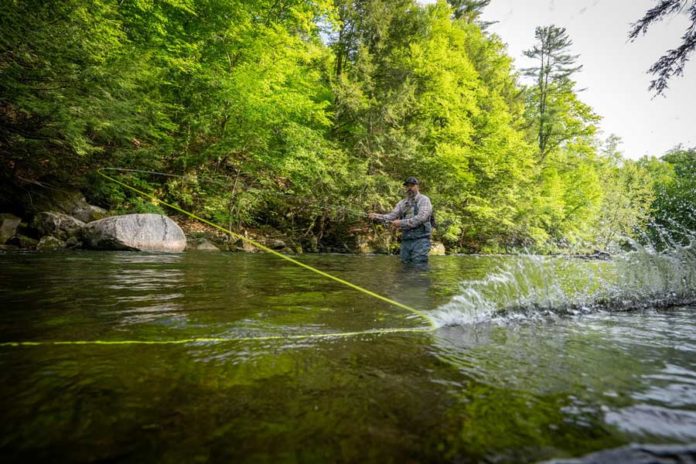Written by: Drew Nisbet
Photo by Drew Nisbet
Trout-spey is a technique for swinging flies down-and-across using light lines on two-handed rods. It is an effective technique for catching fish in any moving water, from your local trout stream to an outgoing tide on an ocean jetty. Trout-spey rods are available in line weights 3 to 5 and are under 12 feet in length.
There are two different line systems typically used to deliver flies with a trout-Spey rod: Scandi and Skagit. These lines are called “heads” and are attached to a thin-diameter running line. Anglers then add a “tip” that either sinks or floats.
“Scandi” casting was developed in Scandinavia, where anglers needed to make long casts with little backcasting room. Scandi heads are designed to carry smaller flies and lighter rigs. These lines, featuring a long taper, are very pleasant to cast, deliver flies at longer distances, and offer a more delicate presentation. A Scandi-head trout-Spey set up is perfect for swinging small wet flies in the upper half of the water column. Scandi heads are typically 20 – 40 feet long and are well suited to be fished with the addition of a floating or intermediate sinking poly leader.

Photo by Drew Nisbet
Skagit heads–named for a river in Washington–are designed to deliver large flies with heavy sink tips to fish in the lower half of the water column. Short and powerful, typically 15 to 22 feet long, Skagit heads are fat and round with an aggressive taper to generate power. The compact taper of these heads means that casting is a bit easier and the range of tips you can use is expanded from heavy and short tips to get the fly deep to longer intermediate tips to suspend the fly along the swing.
Putting it all Together
Most fly anglers are familiar with a trout reel set up, which consists of 100 yards of Dacron backing connected to a tapered fly line that is about 90 feet long. A trout-Spey set up varies from this in a few key ways to allow the angler to adapt their rig to changing conditions.
The components of the complete trout-Spey line system are: Dacron backing, running line, Scandi or Skagit head, tip, and leader. The running line–usually 100 feet long–is a PVC-coated fly line with a very thin diameter, and it is connected to the Dacron backing. The very thin running line is carried forward by the thicker and heavier mass of the Scandi or Skagit head during a cast.
A Scandi or Skagit head is attached to the running line with a loop-to-loop connection. This allows the angler to easily switch out a Scandi or Skagit head, depending on the conditions or flies they’d like to fish.

Next, a tip that either sinks or floats is attached to the Scandi or Skagit head with another loop-to-loop connection. Typically a floating or intermediate tip is used with a Scandi head and a sinking tip is used with a Skagit head. The final component is the leader. For example, if you’re swinging wet flies on a 3-weight with a Scandi head, you might use a 7.5-foot 4x leader, whereas if you’re swinging streamers with a 4-weight and a Skagit head, 4 to 6 feet of straight 8-to 12-pound-test will do the trick.
The interchangeability of a trout-Spey line system is designed for versatility and changing conditions. You can think of the backing and running line on the reel as your base ingredients. The Scandi or Skagit heads, along with the tips, are the options you’ll choose to meet the needs of the conditions you are fishing.
For the new trout-Spey angler, these options can be confusing. A local Orvis retail associate or Orvis dealer can help you pick out the right line system for the fishing you’d like to do.
Click here to check out the Orvis Trout-Spey Collection

Other Resources:
Click here to find the Orvis store or authorized dealer near you.
Orvis Outfitter Team: Call toll-free at 800-778-4778, use our Fishing and Hunting Live Chat, or email your question to fishing@orvis.com or hunting@orvis.com.
Credit: Source link































